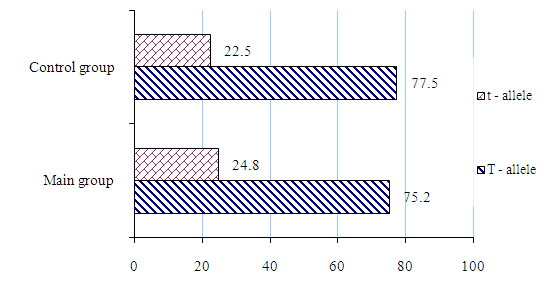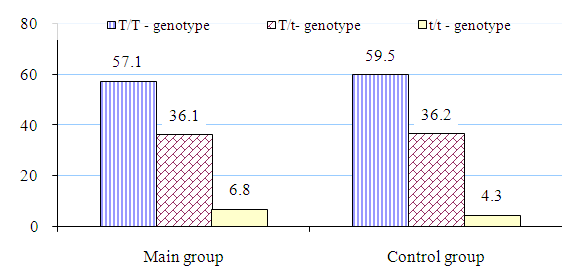-
Paper Information
- Next Paper
- Previous Paper
- Paper Submission
-
Journal Information
- About This Journal
- Editorial Board
- Current Issue
- Archive
- Author Guidelines
- Contact Us
American Journal of Medicine and Medical Sciences
p-ISSN: 2165-901X e-ISSN: 2165-9036
2019; 9(0): 389-392
doi:10.5923/j.ajmms.20190910.07

Osteoporosis in Combination with Osteoarthrosis: Of the rs731236 Polymorphism of the VDR Gene Research
Nasimjon Malikovich Bobaev1, Khamid Yakubovich Karimov2, Kodirjon Tuhtabaevich Boboev2
1Intensive Care Unit, “NURONIY” City Clinical Hospital, Tashkent, Uzbekistan
2Department of Molecular Medicine and Cell Technologies, Scientific Research Institute of Hematology and Blood Transfusion of the Ministry of Health of the Republic of Uzbekistan, Tashkent, Uzbekistan
Correspondence to: Nasimjon Malikovich Bobaev, Intensive Care Unit, “NURONIY” City Clinical Hospital, Tashkent, Uzbekistan.
| Email: |  |
Copyright © 2019 The Author(s). Published by Scientific & Academic Publishing.
This work is licensed under the Creative Commons Attribution International License (CC BY).
http://creativecommons.org/licenses/by/4.0/

The relationship of the pathogenesis of osteoarthritis and osteoporosis continues to be the subject of research specialists. The purpose of this study was to establish the role of the rs731236 polymorphism of the VDR gene in the development of osteoporosis in combination with osteoarthritis. Comparative analysis of the frequency distribution of the genotypes of this polymorphism revealed a trend indicating the significance of the homozygous t/t genotype of the rs731236 polymorphism of the VDR gene in the development of osteoporosis in patients with osteoarthritis.
Keywords: Osteoarthritis, Osteoporosis, rs731236 polymorphism, VDR gene, t/t genotype
Cite this paper: Nasimjon Malikovich Bobaev, Khamid Yakubovich Karimov, Kodirjon Tuhtabaevich Boboev, Osteoporosis in Combination with Osteoarthrosis: Of the rs731236 Polymorphism of the VDR Gene Research, American Journal of Medicine and Medical Sciences, Vol. 9 No. 0, 2019, pp. 389-392. doi: 10.5923/j.ajmms.20190910.07.
Article Outline
1. Introduction
- The relationship of the pathogenesis of osteoarthritis and osteoporosis continues to be the subject of research specialists. The study of the molecular basis of the onset of osteoporosis, for example, identification of associations with the identification of polymorphic loci of candidate genes is one of the topical directions in the study of this pathology [1,2]. Vitamin D homeostasis, the importance of its status and participation in bone formation is known to be indisputable, as is its genetic component, in particular, the distribution of vitamin D (VDR) gene polymorphisms in various populations and pathologies accompanied by a decrease in bone mass and structure [3-5].Considering all the above, a comparative analysis of the distribution of the alleles and genotypes of the TaqI polymorphic locus (T/t, rs731236) of the VDR gene among patients with osteoarthritis and among patients with osteoporosis in combination with osteoporosis was carried out [2,7,8].
2. Main Body
2.1. Purpose of the Study
- The purpose of this study was to establish the role of the rs731236 polymorphism of the VDR gene in the development of osteoporosis in combination with osteoarthritis.
2.2. Material and Methods of Investigation
- The study included a total of 284 subjects, including the main group consisting of 147 people, of which 100 patients had osteoarthritis without osteoporosis (1a-subgroup) and 47 patients with osteoarthritis combined with osteoporosis (1b-subgroup). The control group consisted of 137 conditionally healthy persons of Uzbek nationality.The diagnosis was established on the basis of clinical and anamnestic examination, laboratory tests, X-ray and densitometric studies. In patients with an established diagnosis, the distribution of the DR731236 polymorphic locus of the VDR gene was studied.DNA was isolated from venous blood using a DNA sorb and “Ribo-sorb” kit (AmpliSens®, Russia). The concentration and purity of the isolated DNA was determined on a “NanoDrop 2000” Microvolume UV-Vis Spectrophotometer (ThermoFisher Scientific™, USA).Genotyping of the rs731236 polymorphism of the VDR gene was performed by PCR-RFLP using an Applied Biosystems 2720 instrument.Statistical processing of the research results was performed using the statistical software package “OpenEpi 2009, Version 2.3” and “DoctorStat 2013, Version 1.9”. The following statistical criteria were used: chi-square (χ2), p-criterion, odds ratio (OR) and confidence interval (95% CI).
2.3. Results and Discussion
- Studies have shown that, in general, the distribution of genotypes of the T/t polymorphic locus of the VDR gene in the main and population groups corresponds to the Hardy-Weinberg equilibrium (HWE) (χ2 <0.11, p> 0.74).The data obtained indicate a higher level of detectability of the T allele and T/T genotype, relative to the t allele and other genotypes, both among patients with osteoarthritis and among healthy individuals.In the main and control groups, the T and t alleles of the rs731236 polymorphism of the vitamin D gene (VDR) were distributed as 75.2 / 77.5 and 24.8 / 22.5, respectively.The genotypes of this polymorphic locus were distributed among patients with osteoarthritis and among healthy individuals as follows: T/T: 57.1 / 59.5, T/t: 36.1 / 36.2 and t/t: 6.8 / 4.3.
 | Figure 1. The distribution frequency of the T and t alleles of the rs731236 polymorphism of the VDR gene in patient groups and controls |
 | Figure 2. The frequency of distribution of genotypes T/T, T/t and t/t of the rs731236 polymorphism of the VDR gene in patient groups and controls (%) |
|
3. Conclusions
- Thus, we can conclude that our results in general do not contradict the results of foreign researchers, while complementing and enriching the already existing knowledge about the relationship of the VDR gene with the risk of osteoarthritis and osteoporosis.
 Abstract
Abstract Reference
Reference Full-Text PDF
Full-Text PDF Full-text HTML
Full-text HTML